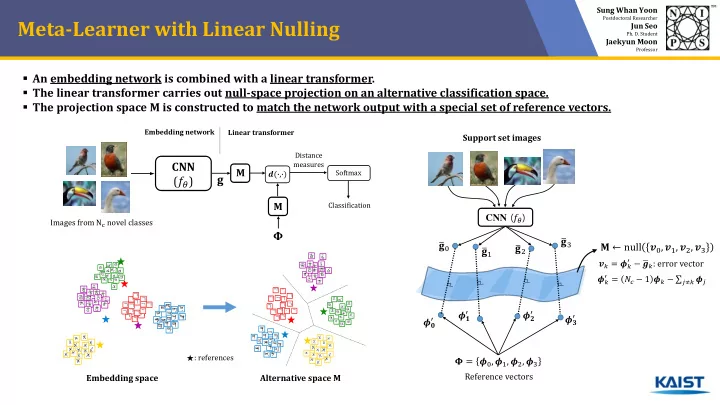

Sung Whan Yoon Postdoctoral Researcher Meta-Learner with Linear Nulling Jun Seo Ph. D. Student Jaekyun Moon Professor � An embedding network is combined with a linear transformer. � The linear transformer carries out null-space projection on an alternative classification space. � The projection space M is constructed to match the network output with a special set of reference vectors. Embedding network Linear transformer Support set images Distance CNN measures 𝐍 Softmax 𝒆(∙,∙) ( 𝑔 𝜄 ) 𝐡 Classification 𝐍 CNN ( 𝑔 𝜄 ) Images from N c novel classes 𝚾 𝐡 3 ത ത 𝐡 0 𝐍 ← null 𝒘 0 , 𝒘 1 , 𝒘 2 , 𝒘 3 𝐡 2 ത 𝐡 1 ത ′ − ഥ 𝒉 𝑙 : error vector 𝒘 𝑙 = 𝝔 𝑙 ′ = 𝑂 𝑑 − 1 𝝔 𝑙 − σ 𝑘≠𝑙 𝝔 𝑘 𝝔 𝑙 ′ ′ 𝝔 𝟐 𝝔 𝟑 ′ 𝝔 𝟒 ′ 𝝔 𝟏 ★ : references 𝚾 = 𝝔 0 , 𝝔 1 , 𝝔 2 , 𝝔 3 Reference vectors Embedding space Alternative space M
Oboe : Collaborative Filtering for AutoML Initialization Chengrun Yang, Yuji Akimoto, Dae Won Kim, Madeleine Udell Cornell University Goal : Select models for a new dataset within time budget. Given : Model performance and runtime on previous datasets. Approach : I low rank dataset-by-model collaborative filtering matrix I predict model runtime using polynomials I classical experiment design for cold-start I missing entry imputation for model performance prediction Performance : I cold-start: high accuracy I model selection: fast and perform well 1 / 1
Backpropamine: meta-learning with neuromodulated Hebbian plasticity Differentiable plasticity : meta-learning with Hebbian plastic connections ● Meta-train both the baseline weight and plasticity of each connection to support efficient ○ learning in any episode In nature, plasticity is under real-time control through neuromodulators ● The brain can decide when and where to be plastic ○ Backpropamine = Differentiable plasticity + neuromodulation ● Make the rate of plasticity a real-time output of the network ○ During each episode, the network effectively learns by self-modification ○ Results: ● Solves tasks that non-modulated networks cannot ○ Improves LSTM performance on PTB language modeling task ○
Toward Multimodal Model-Agnostic Meta-Learning Risto Vuorio 1 , Shao-Hua Sun 2 , Hexiang Hu 2 & Joseph J. Lim 2 University of Michigan 1 University of Southern California 2 Meta-learner Meta-learner The limitation of the MAML family ( ( x x Samples • One initialization can be suboptimal for K × y multimodal task distributions. � θ 1 Multi-Modal MAML τ 1 Task Embedding 1. Model-based meta-learner computes � θ 2 Network task embeddings τ 2 Task 2. Task embeddings are used to … Embedding θ n modulate gradient-based meta-learner υ � τ n 3. Gradient-based meta-learner adapts via gradient steps Modulation Modulation Modulation y Network ˆ Network y Network Model-based Gradient-based Meta-learner Meta-learner
Fast Neural Architecture Construction using EnvelopeNets 1. Finds architecture for CNNs in ~0.25 days 2. Based on the idea of utility of individual nodes. 3. Closely aligns with a theory of human brain ontogenesis.
Meta-Dataset: A Dataset of Datasets for Learning to Learn from Few Examples Eleni Triantafillou, Tyler Zhu, Vincent Dumoulin, Pascal Lamblin, Kelvin Xu, Ross Goroshin, Carles Gelada, Kevin Swersky, Pierre-Antoine Manzagol, Hugo Larochelle ● New benchmark for few-shot classification ● Two-fold approach : 1. Change the data ● Large-scale ● Diverse 2. Change the task creation ○ Introduce imbalance ○ Utilize class hierarchy for ImageNet ● Preliminary results on: baselines, Prototypical Networks, Matching Networks, and MAML. ● Leveraging data of multiple sources remains an open and interesting research direction!
Macro Neural Architecture Search Revisited Hanzhang Hu 1 , John Langford 2 , Rich Caruana 2 , Eric Horvitz 2 , Debadeepta Dey 2 1 Carnegie Mellon University, 2 Microsoft Research Cell Search: the predefined skeleton ensures the simplest cell search can achieve 4.6% error with 0.4M params on CIFAR 10. Key take-away: macro search can be competitive against cell search, even with simple random growing strategies, if the initial model is the same as cell search. Macro Search: learns Cell Search: applies all connections and the found template on layer types. predefined skeleton.
Help Automating Deep Learning Join the AutoDL challenge! https://autodl.chalearn.org AutoDL challenge design and beta tests Zhengying Liu ∗ , Olivier Bousquet, André Elisseeff, Sergio Escalera, Isabelle Guyon, Julio Jacques Jr., Albert Clapés, Adrien Pavao, Michèle Sebag, Danny Silver, Lisheng Sun-Hosoya, Sébastien Tréguer, Wei-Wei Tu, Yiqi Hu, Jingsong Wang, Quanming Yao MetaLearn @ NeurIPS 2018 CiML @ NeurIPS 2018
Modular meta-learning in abstract graph networks for combinatorial generalization Ferran Alet, Maria Bauza, A. Rodriguez, T. Lozano-Perez, L. Kaelbling code&pdf:alet-etal.com Combinatorial generalization: generalizing by reusing neural modules Graph Neural Networks Modular meta-learning Nodes tied to entities Objects Particles Joints Graph Element Networks We introduce: Abstract Graph Networks nodes are not tied to concrete entities OmniPush dataset
Cross-Modulation Extending the feature extraction pipeline of Matching Networks: Networks For ☆ Channel-wise affine transformations: Few-Shot Learning ☆ Subnetwork G predicts the affine parameters and Hugo Prol † , Vincent Dumoulin ‡ , 4x and Luis Herranz † † Computer Vision Center, Univ. Autònoma de Barcelona Max ‡ Google Brain Support Conv BN FiLM ReLU Pool set G Key idea: allow support and Max Query query examples to interact Conv BN FiLM ReLU Pool set at each level of abstraction. 4x
Recommend
More recommend